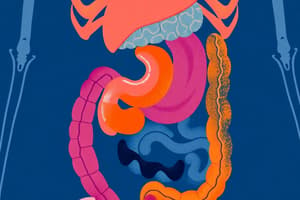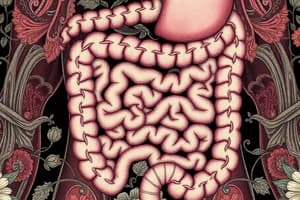Podcast
Questions and Answers
What is the primary function of the liver?
What is the primary function of the liver?
- Producing insulin and glucagon
- Absorbing nutrients from food
- Producing bile and detoxifying chemicals (correct)
- Storing bile for later use
Which organ is responsible for the temporary storage of bile?
Which organ is responsible for the temporary storage of bile?
- Liver
- Appendix
- Gall bladder (correct)
- Pancreas
What is the definition of homeostasis?
What is the definition of homeostasis?
- The process of detoxifying chemicals
- The absorption of nutrients in the intestines
- The state of internal equilibrium maintained by living systems (correct)
- The production of digestive enzymes
What is the primary role of insulin in the body?
What is the primary role of insulin in the body?
Which of the following statements about the appendix is true?
Which of the following statements about the appendix is true?
At what age do wisdom teeth typically begin to erupt?
At what age do wisdom teeth typically begin to erupt?
What is a primary reason some individuals lack wisdom teeth?
What is a primary reason some individuals lack wisdom teeth?
What role does evolution play in the presence of wisdom teeth?
What role does evolution play in the presence of wisdom teeth?
What mechanism moves food from the mouth to the stomach?
What mechanism moves food from the mouth to the stomach?
How long does it typically take for solid food to reach the stomach?
How long does it typically take for solid food to reach the stomach?
What substance does the stomach lining produce for digestion?
What substance does the stomach lining produce for digestion?
What is the primary function of the large intestine?
What is the primary function of the large intestine?
What is the role of the rectum in the digestive system?
What is the role of the rectum in the digestive system?
What is the primary function of the digestive system when food is ingested?
What is the primary function of the digestive system when food is ingested?
What is the role of saliva in digestion?
What is the role of saliva in digestion?
Through which process do nutrients enter the bloodstream?
Through which process do nutrients enter the bloodstream?
Which part of the oral cavity helps separate the digestive and respiratory pathways?
Which part of the oral cavity helps separate the digestive and respiratory pathways?
What is the function of the tongue in the digestive process?
What is the function of the tongue in the digestive process?
What is the total number of permanent teeth that most adults have?
What is the total number of permanent teeth that most adults have?
What type of teeth are commonly referred to as 'baby teeth'?
What type of teeth are commonly referred to as 'baby teeth'?
Which process involves converting nutrients into energy for cellular functions?
Which process involves converting nutrients into energy for cellular functions?
Flashcards are hidden until you start studying
Study Notes
The Digestive System
- Animals need to take in specific substances to survive.
- An animal's anatomy and physiology are linked to its diet and nutrient needs.
- The digestive system is responsible for breaking down food into smaller molecules, absorbing nutrients, and eliminating waste.
- The digestive system comprises the gastrointestinal tract/alimentary canal and accessory organs.
Gastrointestinal Tract
- The gastrointestinal tract is a long, muscular tube that begins at the mouth and ends at the anus.
- The mouth is where mechanical and chemical digestion begins.
- The hard palate is the rigid roof of the mouth, while the soft palate is the posterior part responsible for preventing food from entering the nasal cavity during swallowing.
- The tongue helps with chewing, gathering food into a bolus, and positioning food for swallowing.
- Adults have two sets of teeth: deciduous (baby) teeth and permanent teeth.
- Wisdom teeth are the third molars that usually erupt between the ages of 17 and 24 years old.
- The esophagus is a muscular tube that connects the mouth to the stomach.
- Peristalsis is the wave-like muscle contraction that moves food through the esophagus.
- The stomach is a muscular organ that churns food into chyme and produces digestive juices.
- The small intestine is where nutrients are broken down and absorbed into the bloodstream.
- The large intestine absorbs water and forms solid waste (feces).
- The rectum stores feces before elimination through the anus.
- Sphincter muscles control the movement of stool through the anus.
Accessory Organs
- Accessory organs assist in the digestive process, but are not part of the gastrointestinal tract.
- The liver stores nutrients, produces bile, detoxifies chemicals, and metabolizes drugs.
- The gallbladder stores bile produced by the liver.
- The pancreas produces pancreatic juices aiding digestion and releases hormones (insulin and glucagon) to regulate blood sugar.
- The appendix is a vestigial structure attached to the colon with an unknown function.
Studying That Suits You
Use AI to generate personalized quizzes and flashcards to suit your learning preferences.




